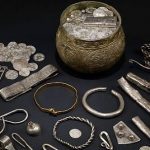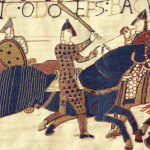 Technology
Technology  Technology
Technology  Humans
Humans 10 Everyday Human Behaviors That Are Actually Survival Instincts
 Animals
Animals 10 Animals That Humiliated and Harmed Historical Leaders
 History
History 10 Most Influential Protests in Modern History
 Creepy
Creepy 10 More Representations of Death from Myth, Legend, and Folktale
 Technology
Technology 10 Scientific Breakthroughs of 2025 That’ll Change Everything
 Our World
Our World 10 Ways Icelandic Culture Makes Other Countries Look Boring
 Misconceptions
Misconceptions 10 Common Misconceptions About the Victorian Era
 Mysteries
Mysteries 10 Strange Unexplained Mysteries of 2025
 Miscellaneous
Miscellaneous 10 of History’s Most Bell-Ringing Finishing Moves
 Technology
Technology Top 10 Everyday Tech Buzzwords That Hide a Darker Past
 Humans
Humans 10 Everyday Human Behaviors That Are Actually Survival Instincts
 Animals
Animals 10 Animals That Humiliated and Harmed Historical Leaders
Who's Behind Listverse?

Jamie Frater
Head Editor
Jamie founded Listverse due to an insatiable desire to share fascinating, obscure, and bizarre facts. He has been a guest speaker on numerous national radio and television stations and is a five time published author.
More About Us History
History 10 Most Influential Protests in Modern History
 Creepy
Creepy 10 More Representations of Death from Myth, Legend, and Folktale
 Technology
Technology 10 Scientific Breakthroughs of 2025 That’ll Change Everything
 Our World
Our World 10 Ways Icelandic Culture Makes Other Countries Look Boring
 Misconceptions
Misconceptions 10 Common Misconceptions About the Victorian Era
 Mysteries
Mysteries 10 Strange Unexplained Mysteries of 2025
 Miscellaneous
Miscellaneous 10 of History’s Most Bell-Ringing Finishing Moves
10 Unusual Places Where Priceless Treasures Were Hidden in WWII
Amid all the details of death and destruction, it is easy to forget that art played an important role in the Second World War. In his youth, Hitler had tried and failed to forge a career as an artist, so during the war, he tried to grab as much land as possible and as many of Europe’s treasures as he could get his hands on. He planned to display many of them in his hometown of Linz in Austria after the war.
As the war expanded across Europe, paintings, jewels, and gold all suddenly had to be hidden to keep them from being damaged or falling into the hands of German forces. Many were hidden in unlikely places, although those that were looted by the Nazis were often hidden just as well. Here are ten of the unusual ways that both sides used to hide art and valuables in the Second World War.
Related: 10 Ways WWII Changed the Allied Home Front
10 A Welsh Quarry
When war with Nazi Germany was declared, British prime minister Winston Churchill ordered that the National Gallery’s collection be moved to “caves and cellars.” This was to protect the priceless works from being damaged or destroyed by German bombs. However, around 2,000 works of art spent the war not in a cave or cellar, but in a quarry in the Welsh town of Blaenau Ffestiniog.
The quarry was usually used to mine slate, but during the war, air-conditioned studios were built inside the mines to house the paintings. A garrison of soldiers was also stationed around the town to protect them, and art experts were nearby to care for them. Among the works hidden in Blaenau Ffestiniog were paintings by some of European art’s biggest names, including Titian, Michelangelo, and John Constable. The plan worked, and the artworks were returned safely to London after the war.[1]
9 An Austrian Salt Mine
The British were not the only ones to store their precious paintings underground. The Nazis also did, sending around 6,500 paintings into an Austrian salt mine during the war for safekeeping. At least, the paintings would be kept safe as long as the Germans emerged victorious. Hitler’s plan was actually to have them blown up if Germany surrendered. This would surely have been a devastating blow for European culture. Again, the collection was teeming with recognizable names like Michelangelo, Vermeer, Rembrandt, and Rubens.
Fortunately, it seems like the locals who worked in the mine and possibly one of the Nazi officials in charge agreed that destroying all that art was a step too far. When the bombs in the mine were detonated, it turned out that they had been swapped for weaker types that only managed to seal off the entrance to the mine. The cool and dark atmosphere inside preserved the paintings well until Allied forces recovered them after the war.[2]
8 A London Tube Station
The Elgin Marbles, also known as the Parthenon Sculptures, are some of the most famous and controversial treasures in Britain. The argument made by Lord Elgin, the art-loving ambassador who brought the sculptures to Britain in the early 1800s, was that they would be safer there than in Athens under Ottoman rule. They have been kept safe ever since, but the biggest threat the sculptures faced came nearly two decades after the Ottoman Empire had vanished, when the German aerial bombing campaign against England began in September 1940.
Like the National Gallery, the British Museum needed to hide and protect its collection, which included the Elgin Marbles. These were harder to move than paintings, so instead of going to an obscure Welsh mine, they were wheeled down the road on wooden carts to Aldwych London Underground station. It already had a disused platform where the museum’s goods had been stored during World War I. The Marbles were kept safe there until 1948, while the British Museum was seriously damaged by the bombs. But they were lucky; it was later discovered that the station would not have survived a direct hit.[3]
7 A Biscuit Tin
Of course, something the British really did not want Hitler getting his hands on were the iconic crown jewels. They certainly would have been a valuable prize had the Nazis invaded, so steps were taken to hide them just in case. This time, the orders did not come from Churchill; they came from King George VI.
His plan was to dig a deep hole at Windsor Castle in which two concrete chambers with steel doors would be built. The work had to be carried out under tarpaulin so enemy aircraft could not see the white chalk being dug out of the ground. Once done, some of the most precious stones from the Imperial State Crown were removed. Probably for protection rather than to fool any enemies who might stumble across the secret chambers, the gemstones were placed in a biscuit tin before being buried.
Sometime after the war, they were recovered, but those involved in the plan died before they ever got around to revealing it to anyone, even to Queen Elizabeth II. She found out after some letters with the details were discovered during research for a 2018 documentary.[4]
6 An Ambulance
Despite being invaded by Germany in 1940, France managed to keep many of its treasures out of harm’s way and out of the hands of the Nazis. That they were able to do this is largely due to the foresight of one man, the director of France’s National Museums, Jacques Jaujard. He had been expecting an invasion ever since he had seen Germany annex Austria in 1938. He hatched a plan along with a curator at the Louvre called René Huyghe to send the museum’s collection to castles, abbeys, and large houses in the French countryside.
In August 1939, he closed the Louvre for three days, claiming it was for repairs. Really, he was having as many items as he could packed carefully into crates and prepared to move. A custom, double-thick case lined with velvet was built for the Mona Lisa, which at one point was strapped to a stretcher and moved by ambulance. This might have been to avoid raising suspicion, but also the doors had been sealed to control the humidity. This was good for the painting, less so for the official who traveled with it. They nearly asphyxiated.[5]
5 A Norwegian Forest
Another country invaded by the Nazis in 1940 was Norway. The Scandinavian nation’s most notable artist is probably Edvard Munch, who painted The Scream. An early version of this piece and some other works by him were hidden deep in a Norwegian forest throughout the war. In Munch’s case, the Nazis did not want to steal his art for display. He was one of the modern artists whose work the Nazis labeled as “degenerate” and banned.
The degenerate art exhibition in Munich had already taken place in 1937, so it was likely that any of Munch’s works they confiscated would never be seen again. When the war started, several of the artist’s paintings were privately owned by a shipping magnate called Thomas Olsen. He had bought them at auction in 1933 after the previous owner, who was Jewish, fled Germany.
When Britain declared war on Germany in 1939, Olsen had his collection moved to a remote barn in a Norwegian forest. It was a sensible move. Although Olsen died in 1969, his family sold their version of The Scream in 2012 for a whopping $119.9 million.[6]
4 An Abandoned Jail Cell
The Nazis might have joined sides with Italy during the war, but this did not stop them from looting the latter’s art. In some cases, they acted under the guise of protecting Italy’s valuable paintings from the conflicts to come, but what they were really doing was storing them away for themselves. They did this in Florence, which was not facing much danger in 1944, when German officers warned the head of the galleries there that his precious collections were not safe.
A number of the paintings mysteriously went missing while being transported to safety. Some of the paintings looted from Italy ended up in Austria, in the salt mine, but the works from Florence that went missing were not among them when the Monuments Men discovered the mine in 1945. However, following the German surrender, an Italian gallery director tipped off the men about a cache of artworks in San Leonardo.
This small village in the Italian Alps held a secret behind the doors of an abandoned jail cell—a collection of paintings worth around $500 million. And that was $500 million in 1945. Today, the incarcerated collection would fetch several billion.[7]
3 In Bread Packages
Not everything looted and hidden by the Nazis was recovered by the Monuments Men. Some of it was so well hidden that it has still never been found. Well, either that or it has been found and taken already. A case in point is the valuable hoard of coins, gemstones, and jewelry believed to be buried in the Dutch village of Ommeren. The value of the treasure supposedly buried there could be in the millions of dollars.
The gold and jewels were looted from a bank in the Dutch city of Arnhem by German soldiers in 1944, but with Allied forces closing in, the loot became a bit too hot to handle. They stuffed it all into ammunition boxes and bread packages before burying them beneath a tree to be recovered later. Despite the declassification of a Nazi soldier’s map, which marks the spot where the treasure is supposed to lay, several official digs and many amateur attempts to find it have failed. Experts have concluded that there likely used to be treasure buried in the village, but it has already been removed.[8]
2 Dissolved into Liquid
Hitler had no problem with gold and other goods coming into Germany, and he did not much care how they were acquired. But gold leaving Germany was strictly illegal and could even result in execution. But people still tried, including Nobel Prize-winning scientists Max von Laue and James Franck. Franck was Jewish, and von Laue was a Jewish sympathizer, so sensing that they were likely to be persecuted, they sent their gold Nobel medals to the physicist Niels Bohr in Copenhagen.
However, the Nazis invaded Denmark in 1940, and there was a risk that their medals would be found. This would lead the Nazis back to the German scientists because Nobel medals are engraved with the names of those to whom they are awarded. But a scientist who worked with Bohr, George de Hevesy, had a plan. He used a powerful corrosive solution called aqua regia to dissolve the gold, leaving just an orange liquid in a beaker. It sat on a shelf in de Hevesy’s lab until after the Nazis were defeated. De Hevesy was then able to extract the gold, which he sent off to Stockholm so that the Nobel medals could be recast.[9]
1 Behind Juice Cartons and Tinned Food
Some paintings looted by the Nazis have never been found, but they might turn up in the future. It has happened before. In 2011, 66 years after the war ended, 1,500 looted works were found in an otherwise mundane Munich apartment belonging to an 80-year-old recluse called Rolf Gurlitt. The hoard was estimated to be worth up to one billion euros and contained paintings by Picasso, Matisse, Munch, and more.
Gurlitt had inherited the lot from his father, a German art dealer who had acquired lots of the so-called “degenerate” art confiscated by the Nazis. He lied to investigators after the war, saying his collection had been destroyed in the Dresden bombings. Inside the dark apartment, the paintings were reportedly stacked on top of each other and hidden behind hundreds of juice cartons and expired tins of food.
The younger Gurlitt was something of a ghost, having never opened a bank account, enrolled in the state pension scheme, or paid any tax. Amazingly, it was the latter that got him in trouble. While he arguably had a moral obligation to return the confiscated art to its previous owners, this was not legally binding.[10]








